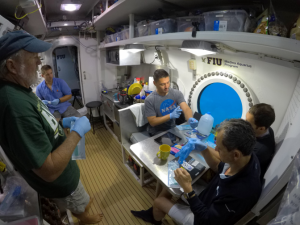
HAB.B | What’s the Aquarius Habitat?
Just What Science Goes on Under the Sea?
Humans have mapped more of the surface of the moon and Mars combined than we have the bottom of the ocean. It’s a big world down there, much of it unknown, and in a strange way, there are some similarities to outer space. In fact, NASA has an underwater facility where they prepare astronauts for missions off planet Earth.
 That place, where sea and space meet, is called the Aquarius Undersea Habitat and Laboratory. This underwater laboratory is located five miles off the coast of Key Largo in Florida. The Aquarius Habitat is the world’s only undersea research station and saturation environment. Astronauts and other scientists live, train, and conduct experiments and research here for up to three weeks at a time, all at a depth of sixty-two feet under the surface of the ocean.
That place, where sea and space meet, is called the Aquarius Undersea Habitat and Laboratory. This underwater laboratory is located five miles off the coast of Key Largo in Florida. The Aquarius Habitat is the world’s only undersea research station and saturation environment. Astronauts and other scientists live, train, and conduct experiments and research here for up to three weeks at a time, all at a depth of sixty-two feet under the surface of the ocean.
It’s called a habitat because that’s exactly what it is: It has its own food, water, air, sleeping facilities, and science stations–everything needed not only to survive, but also to experiment, study, and learn. It’s a very different world than the one we all usually live in for another reason: once anyone is down there for more than a few hours, then they are down there for the whole mission, because the Hab is a “saturation environment.”
Being at a depth of sixty-two feet means that the atmospheric pressure inside the habitat is about two and a half times what it is on the surface, and because of this everyone’s bloodstreams become saturated with nitrogen. That means that they can’t just pop back up to the surface whenever they feel like it.
Let’s Look Around
The first part of the Hab isn’t even on the Hab. To get started, the aquanauts (the people living and working in the Hab) prepare for missions and monitor what’s going on in the Hab from Aquarius Reef Base in Key Largo. The Hab can actually be something of a dangerous place to live and work, so they maintain a significant medical footprint during the missions, and always have a support boat ready at a moment’s notice with a hyperbaric chamber on board in case of emergency. Remember, with a bloodstream full of nitrogen, they can’t just jump into a dive suit and head to the surface.
The Moon Pool
Once the aquanauts arrive by boat to the Aquarius site, they suit up and dive down to the Hab itself, entering through the moon pool, which is just an open hole in the Aquarius floor. Wait, what? There’s a hole in the Hab? Doesn’t water get in? Thanks to the laws of physics, no.
Because the pressure inside the Aquarius is equal to the pressure outside, the air stays in and the water stays out (mostly). Have you ever turned an empty glass over and pushed it straight down into a sink full of water? You’ll see that a large pocket of air will remain in the glass. That’s basically what’s going on in the Hab.

The Wet Porch
Once they enter the Hab through the moon pool, the aquanauts are in the wet porch, which is where they take off their equipment and everyone rinses off with fresh water. Saltwater is corrosive to electronic equipment, metal, clothing, and appliances (pretty much everything but fish), so everything gets a good wash down to try and keep all the salt water in the sea where it belongs.
Once they’ve rinsed and dried — dried as much as possible, that is — they head into the Hab proper to eat, sleep, or run experiments. As you may imagine, it’s always at least a little damp, what with a door to the ocean just a few feet away. On the way, the aquanauts pass the head. Vocabulary alert: “the head” is what we on land generally call “the bathroom.” And what a bathroom it is: small, cramped, and with a curtain instead of a door. Privacy is a rare commodity on the Hab.
In case something goes wrong, a watertight door separates the wet porch from the rest of the Hab. The door, or bulkhead, can be closed and sealed to keep the ocean out if necessary. Be sure to duck your head as you walk through!
Now that you’ve joined us on the Hab proper, we’ll get into the real work of the Hab and talk about where the aquanauts work. Next up. The Science Lock, Life Support systems, Galley and Sleeping quarters. Meet you in the next lesson!
Curriculum Reference Links
- Nature of Science / Understanding About Science / 1: Students should be able to appreciate how scientists work and how scientific ideas are modified over time
- Chemical World / Systems and Interactions / 7: Students should be able to investigate the effect of a number of variables on the rate of chemical reactions including the production
- Physical World / Systems and Interaction / 3: Students should be able to investigate patterns and relationships between physical observables




